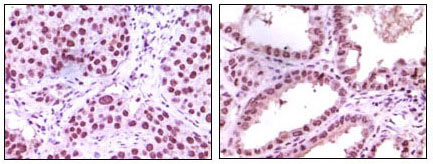GLP Antibody
Purified Mouse Monoclonal Antibody
- SPECIFICATION
- CITATIONS
- PROTOCOLS
- BACKGROUND

Application
| WB, E |
|---|---|
| Primary Accession | Q9H9B1 |
| Reactivity | Human |
| Host | Mouse |
| Clonality | Monoclonal |
| Clone Names | 1B7B4 |
| Isotype | IgG1 |
| Calculated MW | 141466 Da |
| Description | Glucagon-like peptide-1 (GLP-1) is an incretin hormone secreted from enteroendocrine L cells in response to ingested nutrients. The closely related peptides glucagon-like peptide (GLP-1) and glucagon have opposing effects on blood glucose. GLP-1 induces glucose-dependent insulin secretion in the pancreas, while glucagon stimulates gluconeogenesis and glycogenolysis in the liver. Glucagon is processed from a large precursor, proglucagon, in a tissue-specific manner in pancreatic alpha-cells. The identification of a hybrid peptide acting as both a GLP-1 agonist and a glucagon antagonist would provide a novel approach for the treatment of type 2 diabetes. |
| Immunogen | Purified recombinant fragment of GLP expressed in E. Coli. |
| Formulation | Purified antibody in PBS containing 0.03% sodium azide. |
| Gene ID | 79813 |
|---|---|
| Other Names | Histone-lysine N-methyltransferase EHMT1, 2.1.1.-, 2.1.1.43, Euchromatic histone-lysine N-methyltransferase 1, Eu-HMTase1, G9a-like protein 1, GLP, GLP1, Histone H3-K9 methyltransferase 5, H3-K9-HMTase 5, Lysine N-methyltransferase 1D, EHMT1, EUHMTASE1, GLP, KIAA1876, KMT1D |
| Dilution | WB~~1/500 - 1/2000 IHC~~1:200~~1000 |
| Storage | Maintain refrigerated at 2-8°C for up to 6 months. For long term storage store at -20°C in small aliquots to prevent freeze-thaw cycles. |
| Precautions | GLP Antibody is for research use only and not for use in diagnostic or therapeutic procedures. |
| Name | EHMT1 |
|---|---|
| Synonyms | EUHMTASE1, GLP, KIAA1876, KMT1D |
| Function | Histone methyltransferase that specifically mono- and dimethylates 'Lys-9' of histone H3 (H3K9me1 and H3K9me2, respectively) in euchromatin. H3K9me represents a specific tag for epigenetic transcriptional repression by recruiting HP1 proteins to methylated histones. Also weakly methylates 'Lys-27' of histone H3 (H3K27me). Also required for DNA methylation, the histone methyltransferase activity is not required for DNA methylation, suggesting that these 2 activities function independently. Probably targeted to histone H3 by different DNA-binding proteins like E2F6, MGA, MAX and/or DP1. During G0 phase, it probably contributes to silencing of MYC- and E2F-responsive genes, suggesting a role in G0/G1 transition in cell cycle. In addition to the histone methyltransferase activity, also methylates non-histone proteins: mediates dimethylation of 'Lys-373' of p53/TP53. Represses the expression of mitochondrial function-related genes, perhaps by occupying their promoter regions, working in concert with probable chromatin reader BAZ2B (By similarity). |
| Cellular Location | Nucleus. Chromosome. Note=Associates with euchromatic regions |
| Tissue Location | Widely expressed.. |

Thousands of laboratories across the world have published research that depended on the performance of antibodies from Abcepta to advance their research. Check out links to articles that cite our products in major peer-reviewed journals, organized by research category.
info@abcepta.com, and receive a free "I Love Antibodies" mug.
Provided below are standard protocols that you may find useful for product applications.
References
1. Clark Q. Pan, Joanne M. Buxton, Stephanie L. Yung, et al. J Biol Chem. 2006 Feb 27. 2.Michael F. Crutchlow, Jee-Young Nina Ham, et al. Int J Biochem Cell Biol. 2006;38(5-6):845-859. 3.Andrew Young Adv Pharmacol. 2005;52:151-71.
If you have used an Abcepta product and would like to share how it has performed, please click on the "Submit Review" button and provide the requested information. Our staff will examine and post your review and contact you if needed.
If you have any additional inquiries please email technical services at tech@abcepta.com.













 Foundational characteristics of cancer include proliferation, angiogenesis, migration, evasion of apoptosis, and cellular immortality. Find key markers for these cellular processes and antibodies to detect them.
Foundational characteristics of cancer include proliferation, angiogenesis, migration, evasion of apoptosis, and cellular immortality. Find key markers for these cellular processes and antibodies to detect them. The SUMOplot™ Analysis Program predicts and scores sumoylation sites in your protein. SUMOylation is a post-translational modification involved in various cellular processes, such as nuclear-cytosolic transport, transcriptional regulation, apoptosis, protein stability, response to stress, and progression through the cell cycle.
The SUMOplot™ Analysis Program predicts and scores sumoylation sites in your protein. SUMOylation is a post-translational modification involved in various cellular processes, such as nuclear-cytosolic transport, transcriptional regulation, apoptosis, protein stability, response to stress, and progression through the cell cycle. The Autophagy Receptor Motif Plotter predicts and scores autophagy receptor binding sites in your protein. Identifying proteins connected to this pathway is critical to understanding the role of autophagy in physiological as well as pathological processes such as development, differentiation, neurodegenerative diseases, stress, infection, and cancer.
The Autophagy Receptor Motif Plotter predicts and scores autophagy receptor binding sites in your protein. Identifying proteins connected to this pathway is critical to understanding the role of autophagy in physiological as well as pathological processes such as development, differentiation, neurodegenerative diseases, stress, infection, and cancer.



